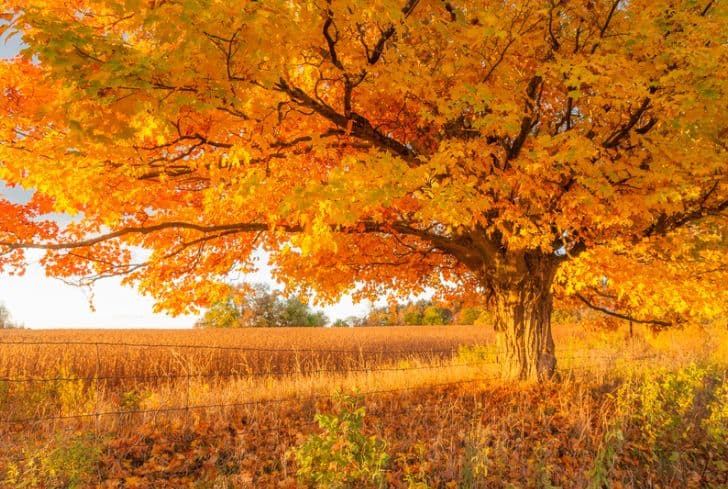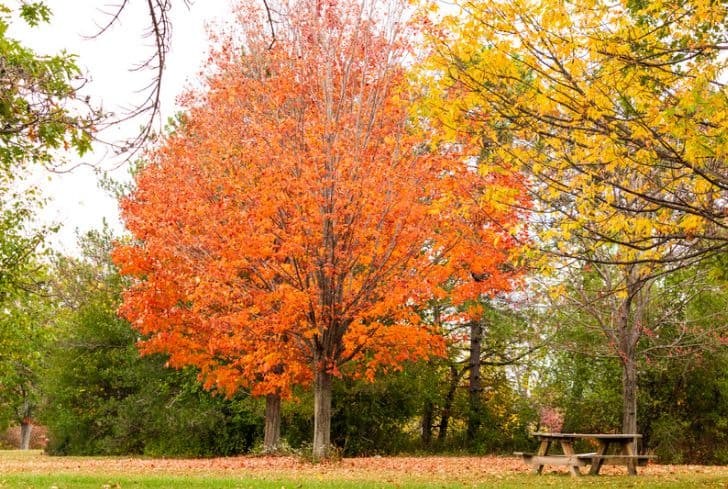Nothing quite compares to sitting under the shade of a large, mature maple tree. While these giant beauties are commonly found in yards and gardens, not every homeowner is aware that their maple tree will bloom with tiny flowers each year.
Since the flowers are so tiny, many people wonder, “when do maple trees bloom?”.
When Do Maple Trees Flower?
Maple trees are some of the most common trees homeowners and landscapers grow in their yards or gardens. With both native and imported species of maples able to thrive in multiple climates, it’s no wonder maple trees are so loved.
Maple trees flower every spring, but the exact blooming time varies by species and climate. Most maple trees will bloom between April and June, producing small and easy-to-miss flowers that grow in red, white, yellow, or green hues. The tiny flowers tend to expand on the terminal branch end. Each flower buds as a stalk and has petals at both the base and the top.
The delicate flowers have been thought to resemble lilies on a much smaller scale. Maple trees are not coveted for their flowers as they don’t produce a show-stopping springtime display like magnolia trees. However, the flowers of a magnolia tree serve the same purpose as all other flowering plants— reproduction.
The blooms are either male or female. Male flowers produce pollen and contain a long central growth called a stamen. The female flowers will have multiple long growths containing a pad at the end. The pads are slightly sticky and are used to catch the pollen.
Maple trees pollinate with the help of pollinating insects like butterflies or bees. Strong breezes can also move pollen from one flower to another efficiently.
Once the female flowers have been pollinated, they will produce their fruit — samaras. These seed sacs float gently to the ground and can be carried by the wind, animals, or humans to plant a new generation of maple trees throughout the land.
When Do Red Maple Trees Bloom?
Red maple trees are some of the most common maple trees grown in North America. They have the ability to adapt to many different climates and soils, increasing their presence in forests and yards throughout the United States and parts of Canada.
Red maple trees are some of the first plants to bloom in the late winter or early spring each year. While trees growing in warmer climates can bloom earlier, most red maple trees begin blooming in March.
Red maple trees get their name from the color of their leaves. However, during the autumn period, red maple leaves can also turn yellow or orange depending on regional genetic differences.
When Do Autumn Blaze Maple Trees Bloom?
The autumn blaze maple tree is known for its renowned and spectacular display of colors in the autumn as the tree begins to lose its leaves. However, if homeowners look closely, they can also see the beauty of tiny flowers blooming in the springtime.
Autumn blaze maple trees bloom in the springtime. Trees grown in warmer climates will see blooms before trees grow in colder climates. However, you can expect to see delicate flowers between March and June each year.
During the autumn months, the leaves will turn a bold red before falling to the ground. Many homeowners love the appeal of the autumn blaze maple tree but should be aware of their root systems. It’s best to plant these trees at least 40-50 feet from your home to prevent any damage.
When Do Japanese Maple Trees Bloom?
As the name suggests, Japanese maple trees are native to Japan. These small, shrub-like trees are wonderful to plant in Zen gardens, landscaping, and can even be used in bonsai. While Japanese maple trees are unique in many ways from other types of maple trees, they still flower like all other varieties.
But when do Japanese maple trees bloom?
You can expect to see a Japanese maple tree bloom between May and June. The exact time frame depends on how warm the year has been and where you live in the United States.
Japanese maples are loved for their small stature and unique foliage. However, not all areas can provide the climate necessary for these beauties to thrive. Generally, USDA zones 6-8 are considered ideal for growing Japanese maple trees.
Do Maple Trees Flower Every Year?
Maple trees aren’t known for large or showy floral displays, but the small, delicate flowers they do produce can be delightful to see. All types of maple tree flower. However, the flowers themselves can be hard to notice, making some believe that their maple tree is not flowering.
Maple trees will flower every year. During the early springtime, a maple tree will produce male, female, or a combination of both flowers. The male flowers have a singular long stamen that produces pollen, whereas the female flowers have sticky stigmas that will catch the pollen.
Maple trees are pollinated either by small insects like bees and butterflies or by the wind. Breezes will blow the pollen from the male flowers to the female flowers, or pollinating insects will help move the pollen from flower to flower. Once pollinated, the female flower then begins to turn into a seed.
In maple trees, the seeds are called samaras. They have also been called shuttlecocks or helicopters and are commonly played with by children. The shape of the samara allows the seeds to flutter far from the maple itself in hopes of producing a new maple tree.
Small maple trees grow quickly from their seeds, so be sure to remove any seedlings you find in your garden or yard before they begin developing a root system. Once established, maple trees can be difficult to remove.

Do Maple Trees Have Invasive Roots?
Since maple trees can grow to be 50 feet tall, many assume that their root systems would be large and possibly problematic. But do maple trees have invasive roots?
Most maple trees don’t have invasive root systems. However, it is important to know which variety of maple you are planting or already have growing in your yard. Silver maple and Norway maple trees have problematic root systems that can cause harm to foundations.
Norway maples are not native to North America. They have been known to become quite problematic, claiming territory and choking out native plants. Silver maple trees have strong root systems that can crack foundations and even cause concrete to buckle and collapse.
Other types of maple trees tend to have shallow root systems that only run about 12-24 inches below the surface. These roots will spread out horizontally underneath the soil, creating an anchor for the maple tree. Fully grown maples can have up to 100 feet of roots entertaining around them.
In addition to their anchor roots, each maple tree has a taproot. A taproot goes straight down from the trunk of the tree. Even in the case of the giant maple tree, its taproot is only 3-4 feet at the deepest.
Even noninvasive maple trees can damage the foundation, so be sure to plant your maple trees at an appropriate distance from your home. If you are planting a smaller variety, 10 feet away from your home is considered safe. For larger varieties, 30 feet from your home is the safest option.
Many homeowners think that the maple tree roots need to physically touch the foundation to cause problems. However, that isn’t the case at all. When roots are near the foundation, they pull all the moisture from the soil in the area, causing the foundation to become dry and crack. They also create the ideal environment for your home to settle on one side and become lopsided.
Do Maple Trees Lose Their Leaves?
Maple trees are considered deciduous trees, which means that they lose their leaves in the fall. When the weather begins to get cold, the chlorophyll in them dies. Chlorophyll is responsible for turning sunlight into energy within the leaves. As they die, the leaves turn beautiful colors before they dry off and eventually fall from the tree.
While the yearly cycle of maple trees losing their leaves is considered natural, if your tree is losing leaves at other points of the year, it may be signaling a problem.
Often during drought or water shortage, the maple tree will try to conserve water. However, when the tree doesn’t receive enough to replenish all of its leaves, the ones located on the ends of the branch tend to die and fall. If you notice small clusters of dried maple leaves falling from your tree, it may need an increase in water intake.
However, don’t fret if the tree is dropping a few leaves. The process is natural and helps keep the tree pruned and healthy.
If you notice the leaves on the ground aren’t dried out but instead look like they were cut from the branch, you might be dealing with maple petiole borers. These small insects are non-stinging wasps that cause maple leaves to drop in the late spring.
Adult sawflies will emerge from the soil and mate before laying eggs near the petiole of maple leaves. The sawfly larvae will enter the petiole through a small hole and begin burrowing through the leaf’s stem. After feeding for 20 to 30 days, the leaf will fall to the ground, completely cut in half at the stem.
The larvae remain on the tree in the petiole for another ten days before falling to the ground, burrowing into the soil, and staying until next spring. It will then emerge as a fully grown adult sawfly and repeat the cycle.
Luckily, there is only one generation of petiole borers each year, and the infested part of the tree tends to be minimal.






